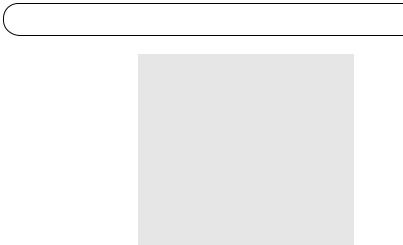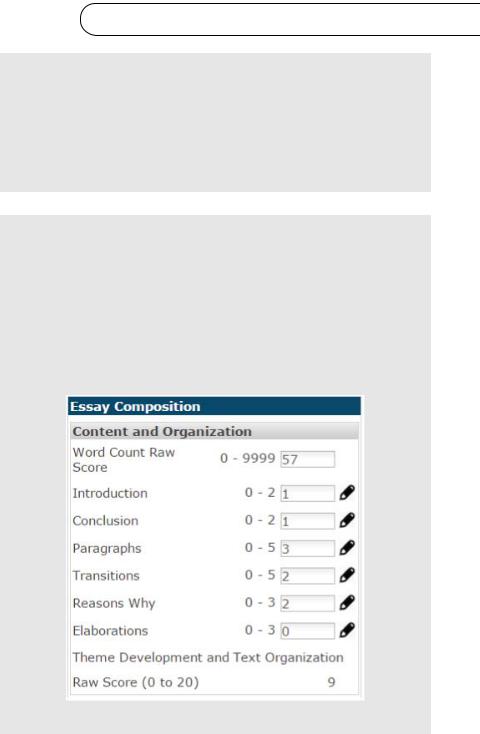
- •Contents
- •Series Preface
- •Acknowledgments
- •Purposes and Uses of Achievement Tests
- •Diagnosing Achievement
- •Identifying Processes
- •Analyzing Errors
- •Making Placement Decisions and Planning Programs
- •Measuring Academic Progress
- •Evaluating Interventions or Programs
- •Conducting Research
- •Screening
- •Selecting an Achievement Test
- •Administering Standardized Achievement Tests
- •Testing Environment
- •Establishing Rapport
- •History and Development
- •Changes From KTEA-II to KTEA-3
- •Subtests
- •Mapping KTEA-3 to Common Core State Standards
- •Standardization and Psychometric Properties of the KTEA-3
- •Standardization
- •Reliability
- •Validity
- •Overview of the KTEA-3 Brief Form
- •Brief Form Standardization and Technical Characteristics
- •How to Administer the KTEA-3
- •Starting and Discontinuing Subtests
- •Sample, Teaching, and Practice Items
- •Recording Responses
- •Timing
- •Queries and Prompts
- •Subtest-by-Subtest Notes on Administration
- •How to Score the KTEA-3
- •Types of Scores
- •Subtest-by-Subtest Scoring Keys
- •How to Interpret the KTEA-3
- •Introduction to Interpretation
- •Step 1: Interpret the Academic Skills Battery (ASB) Composite
- •Step 2: Interpret Other Composite Scores and Subtest Scores
- •Subtest Floors and Ceilings
- •Interpretation of Composites
- •Clinical Analysis of Errors
- •Qualitative Observations
- •Using the KTEA-3 Across Multiple Administrations
- •Repeated Administrations of the Same Form
- •Administering Alternate Forms
- •Using the KTEA-3 Brief Form
- •Progress Monitoring
- •Screening for a Comprehensive Evaluation
- •KTEA-3 Score Reports
- •History and Development
- •Changes From WIAT-II to WIAT-III
- •Age Range
- •New and Modified Subtests
- •Composites
- •Administration and Scoring Rules
- •Skills Analysis
- •Intervention Goal Statements
- •New Analyses
- •New Scores
- •Validity Studies
- •Materials
- •Scoring and Reporting
- •Description of the WIAT-III
- •Subtests With Component Scores
- •Mapping WIAT-III to Common Core State Standards
- •Standardization and Psychometric Properties of the WIAT-III
- •Standardization
- •Reliability
- •Validity
- •Starting and Discontinuing Subtests
- •Sample, Teaching, and Practice Items
- •Recording Responses
- •Timing
- •Queries and Prompts
- •Subtest-by-Subtest Notes on Administration
- •How to Score the WIAT-III
- •Types of Scores
- •Score Reports
- •Subtest-by-Subtest Scoring Keys
- •Listening Comprehension
- •Early Reading Skills
- •Reading Comprehension
- •Sentence Composition
- •Word Reading and Pseudoword Decoding
- •Essay Composition
- •Numerical Operations
- •Oral Expression
- •Oral Reading Fluency
- •Spelling
- •Math Fluency—Addition, Subtraction, and Multiplication
- •Introduction to Interpretation
- •Step 1: Interpret the Composite Scores
- •Subtest Floors and Ceilings
- •Skills Analysis
- •Intervention Goal Statements
- •Qualitative Data
- •Using the WIAT-III Across Multiple Administrations
- •Linking Studies
- •Overview of the WISC-V, WISC-V Integrated, and KABC-II
- •Qualitative/Behavioral Analyses of Assessment Results
- •Identification of Specific Learning Disabilities
- •Interpretation and Use of Three New Composite Scores
- •Accommodations for Visual, Hearing, and Motor Impairments
- •Ongoing Research on Gender Differences in Writing and the Utility of Error Analysis
- •Female Advantage in Writing on KTEA-II Brief and Comprehensive Forms
- •Strengths and Weaknesses of the KTEA-3
- •Assets of the KTEA-3
- •Test Development
- •Two Forms
- •Standardization
- •Reliability and Validity
- •Administration and Scoring
- •Interpretation
- •Phonological Processing
- •KTEA-3 Flash Drive
- •Limitations of the KTEA-3
- •Test Development
- •Standardization
- •Reliability and Validity
- •Administration and Scoring
- •Test Items
- •Interpretation
- •Final Comment
- •Strengths and Weaknesses of the WIAT-III
- •Assets of the WIAT-III
- •Test Development
- •Normative Sample
- •Reliability and Validity
- •Administration and Scoring
- •Interpretation
- •Better Listening Comprehension Measure
- •Technical Manual
- •Limitations of the WIAT-III
- •Floor and Ceiling
- •Test Coverage
- •Poor Instructions for Scoring Certain Tasks
- •Item Scoring
- •Audio Recorder
- •Final Comment
- •Content Coverage of the KTEA-3 and WIAT-III
- •Case Report 1: Jenna
- •Reason for Evaluation
- •Background Information
- •Behavioral Observations
- •Assessment Procedures and Tests Administered
- •Test Results
- •Neuropsychological Implications and Diagnostic Impressions
- •Recommendations
- •Psychometric Summary for Jenna
- •Case Report 2: Oscar
- •Reason for Evaluation
- •Background Information
- •Behavioral Observations
- •Assessment Procedures and Tests Administered
- •Test Results
- •Diagnostic Summary
- •Recommendations
- •Resources
- •Psychometric Summary for Oscar
- •Case Report 3: Rob
- •Purpose of the Evaluation
- •History and Background
- •Behavioral Observations
- •Assessment Procedures and Tests Administered
- •Results
- •Summary and Diagnostic Impressions
- •Recommendations
- •Psychometric Summary for Rob
- •Q-interactive Versus Q-global
- •Equivalency Studies
- •Essential Features of Q-interactive
- •Key Terminology
- •Central Website
- •Assess Application
- •References
- •Annotated Bibliography
- •About the Authors
- •About the Digital Resources
- •Index

WIAT®–III 183
which letter it is. If a letter does not resemble the letter it should be, given its order, do not award credit.
Compare With Other Letters If a student does not write the letters in order, compare similar looking letters with one another.
C A U T I O N
........................................................................................................
Scoring Alphabet Writing Fluency
The maximum possible raw score is 25 because no credit is given for the letter A, which is already provided as an example in the response booklet.
Do not give credit for repetitions of letters, overwriting (letters written on top of other letters), letter reversals, transpositions, or upside-down letters.
Do not penalize for letter form/case, poor/improper letter formation, stray marks, reformation (attempts to correct letter formation issues), or placement on the line.
111111111
Don’t Forget
.....................................................................................................................
Alphabet Writing Fluency Scoring FAQ
Question: A child wrote six perfectly formed letters, but the child provided incorrect names for the letters. For example, the child wrote a U but orally identified it as
a P, and wrote a B but called it a G. Do these letters receive credit?
Answer: Yes, this subtest measures letter formation fluency, not knowledge of letter names/sounds.
Sentence Composition
Sentence Composition is scored post-administration using the scoring rules provided in the Examiner’s Manual. Before scoring, refer to the “Basic Rules of Written Grammar and Mechanics” in Appendix B of the Examiner’s Manual for guidance in

184 ESSENTIALS OF KTEA™-3 AND WIAT®-III ASSESSMENT
Don’t Forget
..........................................................
Tip for Identifying Word Boundary (Mechanics) Errors
Look at the overall writing style of the examinee to identify word boundary errors. If a child habitually writes sentences without any spaces between the words, for example: “Catsarepetsanddogsarealsopets,” do not penalize for word boundary errors. This writing style indicates a more pervasive spacing concern, rather than word boundary errors.
identifying grammar and mechanics errors. Errors that could be attributed to dialect or slang are penalized, except when oral language is being quoted or explicitly referenced.
For Sentence Combining, three areas are scored: (1) Syntax and Semantics,
(2) Mechanics, and (3) Extra Credit. For Sentence Building, two skill areas are scored: (1) Mechanics and (2) Syntax and Semantics. Sentence Building does not include a score for extra credit.
For both Sentence Combining and Sentence Building, use the score boxes provided in the record form to record errors and scores. Examples of scored responses are included in the Scoring Workbook.
Don’t22222222Forget111111111
.....................................................................................................................
Sentence Combining “Extra Credit” Score
Award 1 extra point for each item in which the examinee (a) combined the original sentences into one sentence that means the same thing, (b) did not use poor sentence structure, and (c) did not use the word “and” to join two independent clauses/sentences.
Meeting these criteria indicates a level of syntactic maturity and efficiency that was characteristic of high-achieving examinees in the standardization sample.
Item: Cats are pets. Dogs are pets.
Response example that receives extra credit:
Cats and dogs are pets.
Response examples that do not receive extra credit:
Cats are pets and dogs are pets.
Cats and birds are pets.
Word Reading and Pseudoword Decoding
Prior to administering the Word Reading and Pseudoword Decoding subtests, become familiar with the acceptable pronunciation(s) of each item by listening to the audio files and referring to the pronunciation guides in the Examiner’s Manual.

WIAT®–III 185
This will prepare you to score the examinee’s responses quickly and e ciently during administration. Pronunciations that are not read fluently are scored 0 points. If the examinee makes multiple attempts to read a word, score only the last attempt.
Essay Composition
The Essay Composition subtest standard score is computed by summing the standard score for Word Count
(the number of words written) and the standard score for Theme Development and Text Organization. A supplemental (optional) Grammar and Mechanics standard score is also available.
Word Count and Theme Development and Text Organization (TDTO) are weighted equally when producing the standard score for Essay Composition. The subtest score is essentially a composite of these two scores. Therefore, anytime the subtest score is nonunitary (comprised of discrepant scores between Word Count and TDTO), the overall subtest score should be111111111 interpreted cautiously. Research supports a high correlation between word count and writing quality (Gregg, Coleman, Davis, & Chalk, 2007), meaning that good writers tend to write more and poor writers tend to write fewer words. However, there are exceptions to this general trend. For example, an examinee may score high on Word Count but lower on TDTO. When this occurs, report the separate standard scores for Word Count and TDTO in addition to the subtest standard score to explain performance and plan intervention.
All scoring for this subtest occurs after administration is complete. To begin scoring, read through the examinee’s essay to become familiar with its content and structure. Consider making a photocopy of the essay to write on for scoring purposes.
Scoring Theme Development and Text Organization is easiest using the Scoring Guide provided in Q-global (see Rapid Reference 3.6). For hand scoring, a Quick Score Guide (Pearson, 2010b) is available on the WIAT-III website (www
.pearsonclinical.com) under the Resources tab. Excellent interscorer reliabilities are reported in the Technical Manual for Essay Composition as a whole (0.92–0.99) and for Theme Development and Text Organization specifically (0.92). To acquire this level of proficiency, practice scoring using the Scoring Workbook and then score using the Scoring Guide or Quick Score Guide. The Scoring Guide may be used to score every section of the Theme Development and Text Organization scoring rubric or just specific sections as needed.
To obtain the supplemental Grammar and Mechanics standard score, refer to the scoring rules in the Examiner’s Manual to count the number of Correct Word

186 ESSENTIALS OF KTEA™-3 AND WIAT®-III ASSESSMENT
Sequences and Incorrect Word Sequences. Essentially, a Correct Word Sequence (CWS) is two adjacent words that are correctly spelled, capitalized, and punctuated, and grammatically and semantically acceptable within the context of the sentence. A caret (^) is used to mark each CWS (on a photocopy of the examinee’s essay). If the first word of a sentence is capitalized, always mark a CWS in front of the word. If correct ending punctuation follows the last word of a sentence, always mark a CWS after the word. An Incorrect Word Sequence (IWS) is two adjacent words that do not qualify as a CWS. A dot (•) is used to mark each IWS. To calculate the CIWS score, sum CWS and IWS separately, and subtract IWS from CWS. Refer to the WIAT-III website under the Resources tab for a study called “Assessing Writing Skills Using Correct-Incorrect Word Sequences.” This research supports the reliability and clinical validity of this scoring method.
Don’t Forget
.....................................................................................................................
How to Score Essays That Do Not Respond to the Prompt
Some examinees write essays that do not directly respond to the prompt, which may be a clinically relevant observation. These essays may still be scored. However, if you believe the examinee did not understand the task and would perform much differently
22222222111111111
if the instructions were clarified, you may readminister the subtest at a later time. Examples of essays that do not respond directly to the prompt include the
following. The essay
•Focuses exclusively on explaining the rules or how to play.
•Describes two or more games.
•Gives reasons for liking two or more games.
•Gives reasons for not liking or doing something.
Don’t Forget
.....................................................................................................................
Scoring Tips
Word Count
Do not count crossed-out words.
Incomplete words can be counted if they are understandable as a spelling error or abbreviation.
Illegible handwriting can be counted as a word. It is appropriate to ask the examinee to read his or her writing to confirm the number of words.
(continued)

WIAT®–III 187
(Continued)
Theme Development and Text Organization
Do not penalize for spelling, capitalization, or punctuation errors.
Grammar and Mechanics
Errors that could be attributed to dialect or slang are penalized, except when oral language is being quoted or explicitly referenced.

 Rapid Reference 3.6
Rapid Reference 3.6
.....................................................................................................................
Using the Scoring Guide for Theme Development and Text Organization
In Q-global, the Scoring Guide is accessible by clicking the pencil icon beside each criterion, as shown in the figure below. A Scoring Guide window will open and guide you through the scoring of that criterion. Respond to each question and then click next or save (when complete). When you complete the Scoring Guide, the raw score for that criterion will be entered automatically.
(continued)
